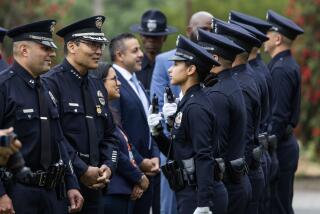San Diego Police Chief Vows Focus on Nonlethal Weapons
- Share via
SAN DIEGO — Reacting to public anger over two fatal shootings by San Diego police, Chief David Bejarano said Tuesday that the department plans to provide officers with more nonlethal weapons and better training on how to deal with agitated or mentally disturbed suspects.
“Life is precious,” Bejarano told the City Council. “We want to make sure we move forward as quickly as possible to get the equipment and training.”
Bejarano said he is determined to make the 2,064-officer department a “pioneer” in finding new ways to defuse potentially dangerous confrontations without the use of guns. He said his goal is to ensure “the safety of our officers and our citizens, without lowering the level of protection we provide the public.”
The comment took on added significance after an incident Monday night in which two officers were shot and wounded by a burglary suspect in a downtown hotel.
The officers returned fire, and the suspect was pronounced dead in the 12th-floor lobby of the Marriott Suites, three blocks from City Hall. Bejarano spent Monday night at the scene of the shooting and then at the hospital where the officers were treated for wounds described as serious but not life-threatening.
With the Marriott shooting in mind, one council member said he hopes that the department is not overreacting to criticism from other shooting incidents.
“We have to be careful that . . . all of a sudden we have all these police officers killed or maimed because they’re afraid to defend themselves,” Councilman Juan Vargas said.
Bejarano’s review of the department’s use of deadly force came in response to a controversy over the fatal shooting in July of an ex-NFL football player and, two weeks ago, of a mentally impaired homeless man armed with a stick.
Demetrius Dubose, a former linebacker for the Tampa Bay Buccaneers, was shot and killed by two officers after he grabbed the martial arts weapons--called nunchakus--they were using in an attempt to subdue him. William Miller, who had a long history of mental illness, was shot and killed by five officers after he charged them while holding a 3-foot walking stick.
Bejarano, a 21-year department veteran who was named chief in April, said there is a “genuine belief by some community members and some police officers that we can do more to adequately prepare and outfit our officers in the field.”
He told council members that every officer will carry in their cars a beanbag shotgun and long-range Taser stun gun, and undergo two days of training in “tactical communication skills.” In the past, only sergeants had Tasers and only the SWAT squad had the beanbag shotguns.
The beanbag shotguns and Tasers would be added to the other nonlethal weapons available to each patrol officer: pepper spray, batons and nunchakus.
The department also is adding more police dogs and a more realistic video training simulator to help officers learn how to subdue combative suspects without firing weapons. Also, the department is testing pepper spray projectiles and nets that can be propelled over a suspect from 25 feet away.
Bejarano told council members that he plans to form a committee of police, community members and experts to review the department’s policy on the use of deadly force.
Bejarano’s move to buy equipment was praised by City Council members and Mayor Susan Golding. But an African American community leader, who helped organize the protest against the Dubose shooting, called it “too little too late.”
“This is more of an attitude adjustment problem than an equipment problem,” said Abdur-Rahmin Hameed, president of a black contractors’ organization. “We will continue to have problems while cops, particularly white cops, are afraid of people of color, particularly of black men, and see them as vengeful and violent.”
Although the fatal shootings of Dubose and Miller were cited as reasons for adding to officers’ array of nonlethal weapons, the cases could just as well be used as examples of how such weapons are either ineffective or counterproductive.
Dubose became more combative after police sprayed pepper spray in his face and used nunchakus in an effort to subdue him. And Miller, according to video taken from a police helicopter, may have been startled into running toward officers by the arrival of a snarling police dog.
Dist. Atty. Paul Pfingst has ruled that the police were justified in using deadly force against Dubose. The Miller shooting is still under review.
The controversy over the Dubose and Miller shootings--including marches, candlelight vigils and angry denunciations of the police--has tended to overshadow the fact that the number of officer-involved shootings has declined sharply over the last decade as San Diego police have improved training.
In 1990, there were 30 officer-involved shootings in San Diego; in 1997, there were 18. Last year, there were seven, including the Dubose death.
Like most departments, San Diego authorizes officers to use deadly force only when confronted with an imminent threat of death or serious injury.
More to Read
Sign up for Essential California
The most important California stories and recommendations in your inbox every morning.
You may occasionally receive promotional content from the Los Angeles Times.













